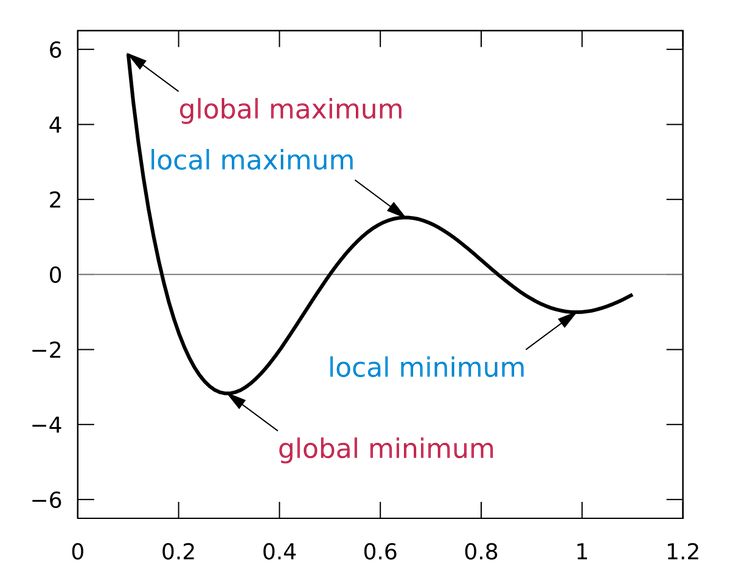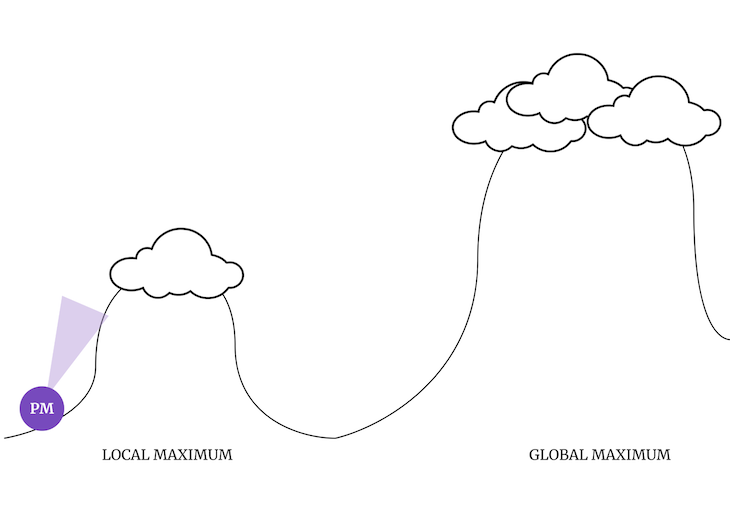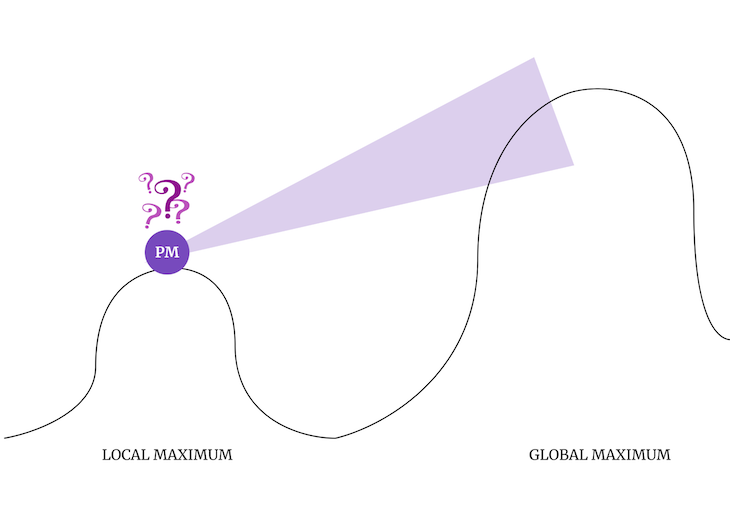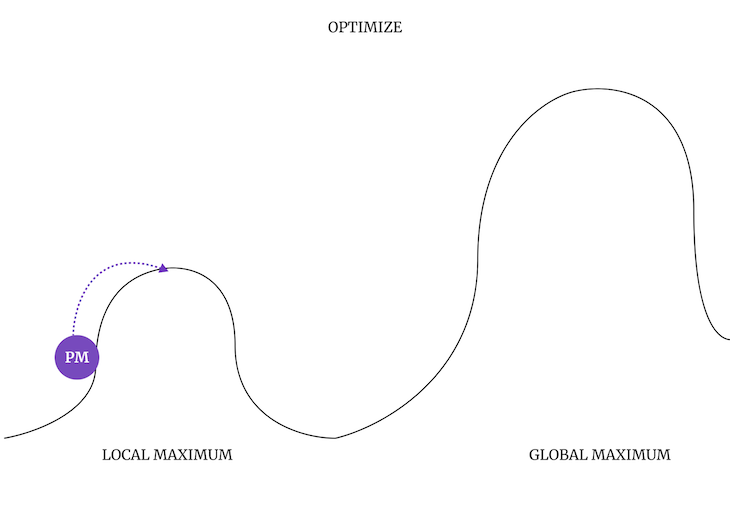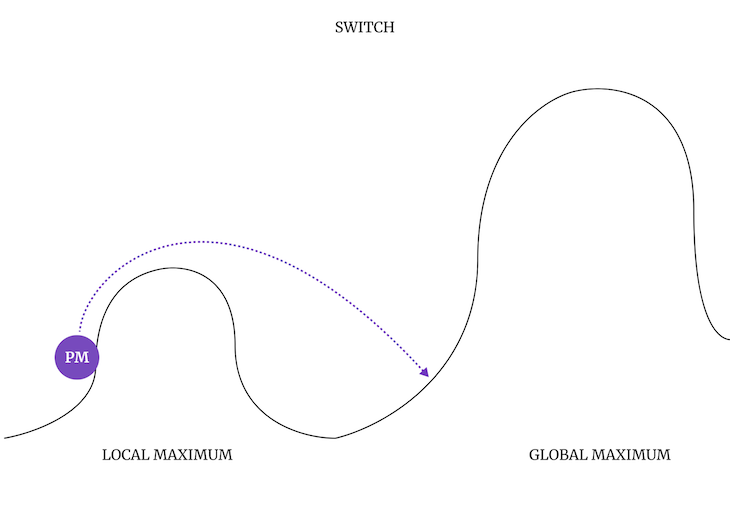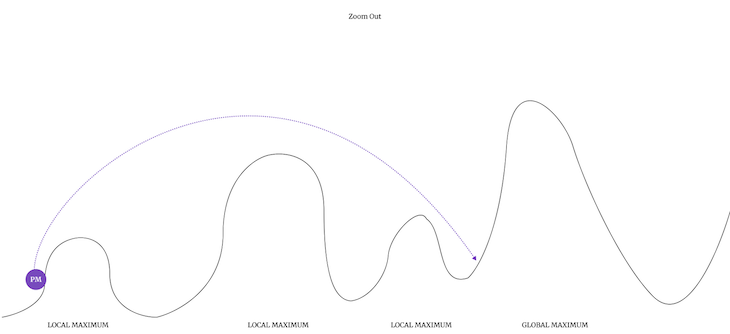Are you currently working on the most impactful areas of your product? Are there any more lucrative opportunities? Should you pursue what you currently have or chase new solutions?
These questions, and more, are in the back of many product manager’s heads on a day to day basis. Answering these can be extremely difficult because they depend heavily on the context and circumstances. As a PM, you should be able to answer these questions to enable your product to thrive.
In this article, you will learn about local and global maxima, which are mathematical concepts that can help you understand the relationship between your product and the markets you’re targeting.
Table of contents
- What are local and global maxima?
- Why should product managers care about local and global maxima?
- How to identify local and global maxima
- Next steps after identifying the maxima
What are local and global maxima?
In mathematics, the global maximum is the largest value in the whole function, while the local maximum is the largest value in a subset of the function.
The following graph illustrates the relationship between global and local maxima:
There can only be a single global maximum for each function, whereas there can be multiple local maxima for each region.
Why should product managers care about local and global maxima?
Now that you have a basic definition, let’s examine how these concepts can be applied to your work as a PM.
A local maximum represents the biggest potential impact you can make in the area you are currently working on, while a global maximum is the highest impact you can make overall.
However, product managers are often so focused on what they do right now that they don’t see past the peak of what they are currently working on:
As a result, you might think you are working on the most impactful opportunity, only to realize that there are bigger opportunities you should be pursuing instead:
As a product manager, you should continuously assess whether you are chasing your global maximum or optimizing for your local maximum.
Many people fall into one of the following common traps:
- “We always focused on that area”
- “Our team works on X”
- “My boss told me to work on this”
- “I was hired to improve X”
While each team has boundaries on what they can work on, remember that PMs are hired primarily to drive business impact. Sometimes it means challenging supervisors and your area of focus.
By focusing only on what you are currently working on, you might realize that you weren’t working on the most impactful solutions.
How to identify local and global maxima
Local maximum is nothing more than a well-informed guess.
Take a deeper look at the problems you are currently working on and the types of solutions envisioned for solving these problems. Now try to answer the question, “What’s the maximum feasible impact you can drive if you continue doing this for the next year?”
For example, if you are working on your trial experience, and your current CVR percent trial to subscription is 50 percent, and you feel you won’t be able to push it past 70 percent (not everyone will convert), then that’s 20 percent difference from your local maximum.
What would happen if you drove the CVR percent trial to subscription from 50 percent to 70 percent? How would it impact your MRR, number of subscribers, etc.?
That’s the local maximum of pursuing this direction.
Identifying global maximum
After you identify your local maximum, start by challenging and optimizing your product to target your local goals.
Ask yourself, “Is this the best way to solve the problem?” Say you are trying to drive customer satisfaction by implementing segmentation and personalization. Is there any other way to drive satisfaction? Investigate them and try to come up with a back-of-napkin estimate.
Assess multiple scenarios to chase your desired outcome through a range of solutions. There’s no need to be super analytical yet; back-of-napkin estimates are enough.
The opportunity with the highest estimated impact is your global maximum.
Next steps after identifying the maxima
After assessing your local and global maxima, you can take three actions:
Optimize for your current solutions
Optimizing for current solutions, even if they are geared toward the local maximum, isn’t inherently wrong. You might decide to pursue the local maximum if:
- You have a robust body of knowledge to improve in that area
- You are already heavily invested and the switching cost is not worth it
- It’ll help you reach your short-term goals faster
Just make sure you make a conscious decision and consider the global maximum. You want to avoid limiting your product to a narrow market when you might have the potential for much greater.
Chase global maximum
Another option is to pivot and chase the global maximum instead. Although the pivots are expensive in the short term, this trade-off might help you drive more long-term impact.
Switch to global maximum if:
- There’s a high enough difference in the potential to justify the switching costs
- You’ve reached the point of diminishing returns in your local maximum
Just remember that switching to a global maximum can actually slow you down in the short run.
Zoom out to see a bigger picture
So much of what you see depends on the way that you look at it.
If you focus purely on your “business areas,” you’ll see only related opportunities. But sometimes, it’s worth taking a step back and considering if what you are working on makes the most sense for your direction
Maybe it’s even worth changing direction?
Say you are working for the Uber-like ride sharing app. Your supervisor’s key metric is revenue. They taxed you with a customer satisfaction metric to drive retention. But is customer satisfaction the best way to drive revenue? Maybe there’s a bigger impact in working on driver satisfaction (more drivers = bigger market share = more revenue).
If another PM focuses on driver satisfaction, maybe there’s an unowned area with a higher impact. Maybe building community is the way to go?
Consider the following diagram:
On occasion, zoom out and consider how you could drive impact if there weren’t any boundaries in place. You might discover exciting opportunities you would never think about.
Wrap up
The concepts of local and global maxima are a valuable tool for day-to-day product management work. Regularly assessing local and global maxima can help PMs answer whether they are working on the most impactful thing and if they should continue with current solutions or explore new ons.
Keep in mind, your maxima changes as the circumstances change. For example, recent AI development unlocked new ways of solving problems and serving customers, creating a brand new global maximum for many.
Yesterday’s global maximum might be today’s local maximum. Remember to look toward the future.
Featured image source: IconScout
The post Understanding global and local maxima to build better products appeared first on LogRocket Blog.
from LogRocket Blog https://ift.tt/58Aj2dm
Gain $200 in a week
via Read more



